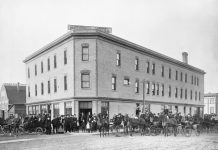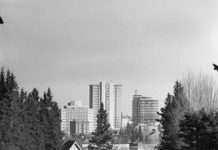908a Centre St. N.E., Crescent Heights
The Tigerstedt Block is significant as one of the remaining unaltered commercial streetscapes whose initial construction circa 1928 marked the early development of Centre St. North south of 16th Avenue (Highway No.1) as a neighbourhood high street.
The Village of Crescent Heights was annexed to the city of Calgary in 1908 and the south end of Centre Street was the last portion to develop, due in large part to the post WWI economic recession which continued until the mid-1920s, despite the opening of the new Centre St. Bridge in 1916 and the installation of a streetcar line in 1919.
By 1925-1928 the south end of Centre St. N. was seen to have a number of advantages including easy access to downtown, the city’s primary shopping district, and by then was able to establish itself as a commercial district distinct, between 16 and 7 Avenues, fueled by a city-wide population increase of nearly 20,000 between 1926 and 1931. The Tigerstedt Block stands as one of a few remaining retail commercial buildings to recall Centre St. neighbourhood’s high street status that was established in the 1920s.
The development of the site spans the 1928 pre-crash commercial boom through the downturn of the 1930s and early 1940s up to the post World War II recovery era which was marked by increasing suburban expansion throughout the city and attendant commercial strip development to serve the needs of an increasing population in the post-WWII period.
This modest single storey commercial ensemble is typical of strip development bordering residential working-class neighbourhoods during its development period. The northernmost portion of the building (918-92) appears to have been specifically constructed in 1952 to accommodate the photographic studios of Albert Tigerstedt, which had originally been located at 908 (1936 to 1944) and subsequently relocated to 908A around 1945. Tigerstedt was a well-known local photographer specializing in portraiture and commercial photography, who had apprenticed with W.J. Oliver and whose subjects included well-known Calgary personalities. He served in the Royal Canadian Navy as a photographer between 1943 and 1945 and remained at 922 until his retirement in 1987. During his 55 years in business, Tigerstedt was one of the most prominent photographers in the city. Tigerstedt maintained his studio in the basement and a retail store on the ground floor. Even after retiring, Tigerstedt occupied space in the building until about 1992.
The Tigerstedt Block is notable as a now rare example in the city of modest commercial-style architecture from the inter-WWI-WWII era. Constructed of commonly available materials, the storefronts include brick outer piers, large plate-glass display windows with recessed entries, and tile detailing below the windows and framing sign bands. The building is dominated by a 10-foot projecting neon sign featuring multi – coloured tubing, in an inverted ‘T’, containing the lettering `Tigerstedt Block’. The distinctive sign has assumed landmark status as one of the very few extant neon signs in the city dating from the early 1950s. The building itself is also a landmark due to its prominence within the Centre Street streetscape because of its substantial size and historical character.









